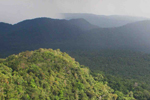The Cambodian government has handed over nearly 20 percent of Botum Sakor National Park to a Chinese real-estate firm building a massive casino and resorts in the middle of pristine rainforest, reports Reuters. The city-sized resorts, costing $3.8 billion, will include a 64 kilometers highway, an airport, hotels, and golf courses. Botum Sakur is home to a number of endangered species including the pileated gibbon (Hylobates pileatus) and Asian elephant (Elephas maximus).
“Cambodia is giving away 36,000 hectares to a foreign entity with little if any oversight or obvious benefit to the people,” Mathieu Pellerin, a researcher with Cambodian human rights group Licadho, told Reuters. Construction of the pleasure cities by Union Group is displacing local Cambodians, some who have lived there for generations.
Researchers have recorded 44 mammal species and 533 birds in the park. Other imperiled species include the white winged duck (Asarcornis scutulata), Sunda pangolin (Manis javanica), Asian slow loris (Nycticebus bengalensis), Indochinese silvered langur (Trachypithecus germaini), hog deer (Axis porcinus), dhole (Cuon alpinus), the elongated tortoise (Indotestudo elongate), the Siamese crocodile (Crocodylus siamensis), and the fishing cat (Prionailurus viverrinus).
This is not the first time Cambodia has taken land from conservation areas. Last year the government carved out 9,000 hectares from Virachey National Park for a rubber plantation. In 2007 the government approved Australian gold-mining company, Indochine Mining, rights to exploratory mining in half the park.
Recently Licadho released a report showing that more than half of all Cambodia’s arable land had been handed to private corporations as economic land concessions.
Related articles
Photos: Cambodians rally as ‘Avatars’ to save one of the region’s last great rainforests

(05/31/2011) Two hundred Cambodians rallied in Phnom Penh last week to protest the widespread destruction of one of Southeast Asia’s last intact lowland rainforests, known as Prey Lang. In an effort to gain wider media attention, protestors donned dress and make-up inspired by the James Cameron film, Avatar, which depicts the destruction of a forest and its inhabitants on an alien world. The idea worked as the rally received international attention from Reuters, CNN (i-report), MSNBC, and NPR, among other media outlets.
Cambodia’s wildlife pioneer: saving species and places in Southeast Asia’s last forest

(05/11/2011) Suwanna Gauntlett has dedicated her life to protecting rainforests and wildlife in some of the world’s most hostile and rugged environments and has set the trend of a new generation of direct action conservationists. She has designed, implemented, and supported bold, front-line conservation programs to save endangered wildlife populations from the brink of extinction, including saving the Amur Tiger (also known as the Siberian Tiger) from extinction in the 1990s in the Russian Far East, when only about 80 individuals remained and reversing the drastic decline of Olive Ridley sea turtles along the coast of Orissa, India in the 1990s, when annual nestings had declined from 600,000 to a mere 8,130. When she first arrived in Cambodia in the late 1990s, its forests were silent. ‘You couldn’t hear any birds, you couldn’t hear any wildlife and you could hardly see any signs of wildlife because of the destruction,’ Gauntlett said. Wildlife was being sold everywhere, in restaurants, on the street, and even her local beauty parlor had a bear.
(04/11/2011) In a surprise move, the Cambodian Prime Minister, Sandech Hun Sen, has cancelled a titanium strip mine project in one of Southeast Asia’s last great intact forest ecosystems, the Cardamom Mountains. According to a press release sent out by the Cambodian government the mine was canceled due to “concerns of the impact on the environment, biodiversity and local livelihoods” of villagers. The mine, which was planned to sit directly in the migration route for the largest population of Asian elephants in Cambodia, had been largely opposed by locals in the region who spent years developing eco-tourism in the region.